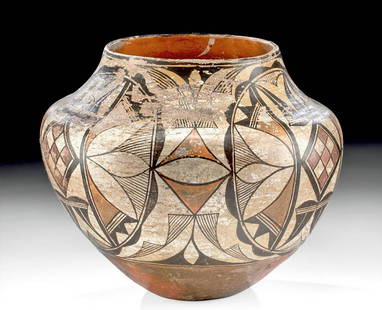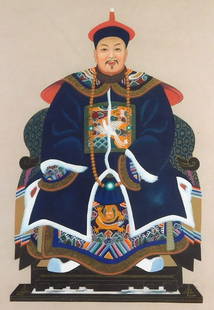
Enormous 20th C. Shipibo Polychrome Portrait Jar
Similar Sale History
Recommended Items







Item Details
Description
South American, Upper / Western Amazon Basin, Ucayali River, Peru, Shipibo people, ca. mid-20th century CE. Wow! A marvelous pottery portrait jar of a tremendous size featuring a dramatically wide hip, a sloped shoulder, a conical neck, and a flared rim, all sitting upon a narrow base. Quite captivating, the neck of the vessel presents the visage of an individual, displaying petite eyes with round pupils, a pinched nose with delineated nostrils, and a slender mouth held in a gentle smile, all flanked by a pair of cupped ears. A lovely burnt orange slip envelops the area below the hip as well as the interior rim, while the exterior of the shoulder, neck and rim are adorned with a mesmerizing, mazelike design of black and orange painted interlocking motifs atop a creamy beige ground. Size: 20.5" Diameter x 19" H (52.1 cm x 48.3 cm)
These symmetrical geometric patterns, known as kene, are not only said to represent the paths of life, but are also inspired by nature, such as in the coils and scaled skin of a snake, which are also symbolic of the coiling of the pottery as the vessel is constructed. Layers of zigzag patterns arch below the jutting chin of the face, possibly representing a beard or collar necklace, while black resin embellishes the interior walls of the jar.
The Shipibo-Conibo tribe are an indigenous people along the Ucayali River in the Amazon rainforest in Peru. Shipibo vessels are visually distinctive and instantly recognizable, the result of a tempering technology that is millennia old, allowing for some of the largest, thinnest-walled vessels produced in the New World. These vessels are made by Shipibo women in a style that grew out of the pre-Columbian Marajoara. The chomo is a vessel that can be placed into a hole dug in the ground to store and ferment masato, a ceremonial beverage used in ceremonies like the Joni-Ati, an initiation ritual to mark a girl's passage into womanhood. The Shipibo, unlike many other Amazonian tribes, are matriarchal. This massive vessel would have played an important role in the life of these fascinating people.
Shipibo art generally appears in multimedia enveloped in elaborate geometric designs in a baroque trilevel style. Decorated first, the upper level is comprised of broad form lines in rectilinear (pontequeneya) and curvilinear (mayaqueneya) patterns. Artists are inspired by covering her eyelids with the leaves of an iponquene plant - named after a small but complexly patterned armor-headed catfish - in an effort to absorb their intricate tracery, as well as via dreams and visions. The original designs were from hallucinogenic visions of shamans using ayahuasca (or nishi) and strong tobacco. According to the Smithsonian National Museum of the American Indian, "In mythic times these patterns covered everything - the sky, trees, huts, people, animals, et cetera - in a continuous tissue of design. But due to the misdeeds of failed protohumans, this idyllic union ruptured and differentiated into floating, superimposed planes: Nete shama (the sky world), Mai (the earth world), and Jene shama (the subaquatic underworld). Simultaneously, periodicity (day and night, or time), mortality, and speciation appeared. And the geometric lineaments ruptured. Now they appear only on specific design fields, such as the upper parts of fineware pottery, people's faces, or the blades of war clubs. All these designs are pre-existent; the artist has only to grasp and fix them in her mind (shinan picotai, 'the thoughts emerge'), lay them over the design field, and cut where they match that field, letting the rest of the design fade back into invisibility. The visible design remains as a window into the vast reticulate intricacy of the universe."
Cf. Smithsonian National Museum of the American Indian, 26/3329 and 23/9608.
Provenance: private Hidden Valley Lake, California, USA collection; ex-Clark's Auction Company, Scotts Valley, California, USA, "CA Estates Native American & WWII Collections," April 26th, 2020, lot 133
All items legal to buy/sell under U.S. Statute covering cultural patrimony Code 2600, CHAPTER 14, and are guaranteed to be as described or your money back.
A Certificate of Authenticity will accompany all winning bids.
PLEASE NOTE: Due to recent increases of shipments being seized by Australian & German customs (even for items with pre-UNESCO provenance), we will no longer ship most antiquities and ancient Chinese art to Australia & Germany. For categories of items that are acceptable to ship to Australia or Germany, please contact us directly or work with your local customs brokerage firm.
Display stands not described as included/custom in the item description are for photography purposes only and will not be included with the item upon shipping.
#170428
These symmetrical geometric patterns, known as kene, are not only said to represent the paths of life, but are also inspired by nature, such as in the coils and scaled skin of a snake, which are also symbolic of the coiling of the pottery as the vessel is constructed. Layers of zigzag patterns arch below the jutting chin of the face, possibly representing a beard or collar necklace, while black resin embellishes the interior walls of the jar.
The Shipibo-Conibo tribe are an indigenous people along the Ucayali River in the Amazon rainforest in Peru. Shipibo vessels are visually distinctive and instantly recognizable, the result of a tempering technology that is millennia old, allowing for some of the largest, thinnest-walled vessels produced in the New World. These vessels are made by Shipibo women in a style that grew out of the pre-Columbian Marajoara. The chomo is a vessel that can be placed into a hole dug in the ground to store and ferment masato, a ceremonial beverage used in ceremonies like the Joni-Ati, an initiation ritual to mark a girl's passage into womanhood. The Shipibo, unlike many other Amazonian tribes, are matriarchal. This massive vessel would have played an important role in the life of these fascinating people.
Shipibo art generally appears in multimedia enveloped in elaborate geometric designs in a baroque trilevel style. Decorated first, the upper level is comprised of broad form lines in rectilinear (pontequeneya) and curvilinear (mayaqueneya) patterns. Artists are inspired by covering her eyelids with the leaves of an iponquene plant - named after a small but complexly patterned armor-headed catfish - in an effort to absorb their intricate tracery, as well as via dreams and visions. The original designs were from hallucinogenic visions of shamans using ayahuasca (or nishi) and strong tobacco. According to the Smithsonian National Museum of the American Indian, "In mythic times these patterns covered everything - the sky, trees, huts, people, animals, et cetera - in a continuous tissue of design. But due to the misdeeds of failed protohumans, this idyllic union ruptured and differentiated into floating, superimposed planes: Nete shama (the sky world), Mai (the earth world), and Jene shama (the subaquatic underworld). Simultaneously, periodicity (day and night, or time), mortality, and speciation appeared. And the geometric lineaments ruptured. Now they appear only on specific design fields, such as the upper parts of fineware pottery, people's faces, or the blades of war clubs. All these designs are pre-existent; the artist has only to grasp and fix them in her mind (shinan picotai, 'the thoughts emerge'), lay them over the design field, and cut where they match that field, letting the rest of the design fade back into invisibility. The visible design remains as a window into the vast reticulate intricacy of the universe."
Cf. Smithsonian National Museum of the American Indian, 26/3329 and 23/9608.
Provenance: private Hidden Valley Lake, California, USA collection; ex-Clark's Auction Company, Scotts Valley, California, USA, "CA Estates Native American & WWII Collections," April 26th, 2020, lot 133
All items legal to buy/sell under U.S. Statute covering cultural patrimony Code 2600, CHAPTER 14, and are guaranteed to be as described or your money back.
A Certificate of Authenticity will accompany all winning bids.
PLEASE NOTE: Due to recent increases of shipments being seized by Australian & German customs (even for items with pre-UNESCO provenance), we will no longer ship most antiquities and ancient Chinese art to Australia & Germany. For categories of items that are acceptable to ship to Australia or Germany, please contact us directly or work with your local customs brokerage firm.
Display stands not described as included/custom in the item description are for photography purposes only and will not be included with the item upon shipping.
#170428
Condition
Expected nicks, abrasions, scratches, and pitting in some areas, commensurate with age. Loss to some black resin on interior. A few scattered areas of minor peeling to surface. Otherwise, intact and excellent with impressive remaining pigments and nice preservation of painted detail.
Buyer's Premium
- 26.5%
Enormous 20th C. Shipibo Polychrome Portrait Jar
Estimate $1,300 - $1,950
21 bidders are watching this item.
Shipping & Pickup Options
Item located in Louisville, CO, usOffers In-House Shipping
Local Pickup Available
Payment

Related Searches
TOP


















































